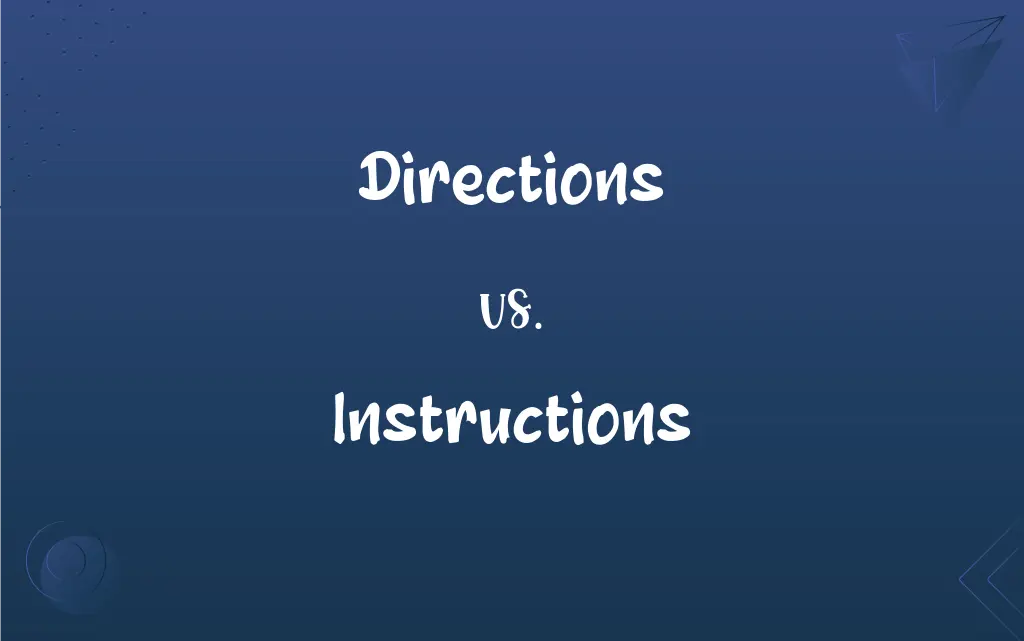Directions vs. Instructions: What's the Difference?
Edited by Janet White || By Harlon Moss || Updated on October 18, 2023
Directions guide the way or route; instructions guide the process.

Key Differences
Directions typically refer to the guidance on how to reach a specific destination, while instructions involve detailed steps on how to perform a task. Both words involve guiding, but the former is spatial, and the latter is procedural.
When we talk about directions, we often think about maps, routes, or pointers that lead us to a place. On the other hand, instructions usually come in the form of a manual or guide, detailing the sequence to achieve a result.
If someone is lost, they might ask for directions to find their way back. However, if someone is unsure how to operate a machine, they'd ask for instructions.
To further differentiate, consider cooking. One might get directions to a store to buy ingredients, but inside a cookbook, they'd find instructions on how to prepare the dish.
In summary, while both directions and instructions serve to guide, directions lean towards navigation, whereas instructions focus on methodical tasks.
ADVERTISEMENT
Comparison Chart
Nature
Spatial
Procedural
Common Usage
Navigational guide
Step-by-step guide
In Manuals
Shows where components are placed
Explains how to use or assemble
Dependency
Relies on landmarks or spatial references
Relies on prior steps or information
Examples
Maps, compass readings
Recipe steps, assembly guides
ADVERTISEMENT
Directions and Instructions Definitions
Directions
A course along which someone moves.
The wind changed directions suddenly.
Instructions
Guidelines provided to ensure proper use.
The medicine bottle has instructions on the dosage.
Directions
The management or guidance of someone or something.
The company has flourished under her directions.
Instructions
A detailed guide on how to do something.
The furniture came with instructions for assembly.
Directions
A general way in which something is developing.
The directions of our research have shifted over the years.
Instructions
Information conveyed in teaching.
She provided instructions in mathematics to her students.
Directions
Instructions on how something should be done.
The game comes with directions on how to play.
Instructions
A computer operation defined by the software.
The program executes several instructions per second.
Directions
Guidance on reaching a place.
Can you give me the directions to the nearest gas station?
Instructions
Orders or directives given by someone in authority.
He gave strict instructions not to open the door.
Directions
The management, supervision, or guidance of a group or operation
The manager's direction of the sales campaign has been highly effective.
Instructions
The act, practice, or profession of instructing
Math instruction.
Directions
The art or action of directing a musical, theatrical, or cinematic production.
Instructions
Imparted knowledge
We sought further instruction in a more advanced class.
FAQs
Are instructions only for tangible tasks?
No, they can also guide abstract tasks like problem-solving.
Can directions sometimes mean advice on how to do something?
Yes, like when given "directions" on how to use a product.
Do instructions always involve a sequence of steps?
Generally, yes. Instructions often detail a process or method.
Can directions be verbal?
Yes, like when someone verbally guides you to a place.
In a film, who provides directions?
The director provides the artistic direction.
Which word, directions or instructions, is more related to navigation?
Directions.
Are road signs a form of directions?
Yes, they guide travelers on routes.
Can directions refer to future paths or strategies?
Yes, as in the "directions" a company plans to take.
What's the key difference between directions and instructions?
Directions guide the way; instructions guide the process.
What's a common tool to provide directions?
Maps or GPS devices.
In teaching, what's a synonym for instructions?
Guidance or tutoring.
In computing, which word, directions or instructions, relates to commands given to a computer?
Instructions.
Is a recipe a form of instructions?
Yes, it provides steps to prepare a dish.
Are instructions always written?
No, they can be verbal, visual, or written.
What might you find if you lack clear instructions?
You might face confusion or mistakes in the task.
What's a synonym for directions in the context of a path?
Route.
Can a device manual have both directions and instructions?
Yes, it can show component placements (directions) and how to use them (instructions).
Do instructions always come before a task?
Generally, yes. They prepare someone for a task.
In which context are both directions and instructions used interchangeably?
Sometimes, when referring to guidelines on how to do something.
Which is more specific, directions or instructions?
Typically, instructions, as they often detail specific steps.
About Author
Written by
Harlon MossHarlon is a seasoned quality moderator and accomplished content writer for Difference Wiki. An alumnus of the prestigious University of California, he earned his degree in Computer Science. Leveraging his academic background, Harlon brings a meticulous and informed perspective to his work, ensuring content accuracy and excellence.
Edited by
Janet WhiteJanet White has been an esteemed writer and blogger for Difference Wiki. Holding a Master's degree in Science and Medical Journalism from the prestigious Boston University, she has consistently demonstrated her expertise and passion for her field. When she's not immersed in her work, Janet relishes her time exercising, delving into a good book, and cherishing moments with friends and family.































































